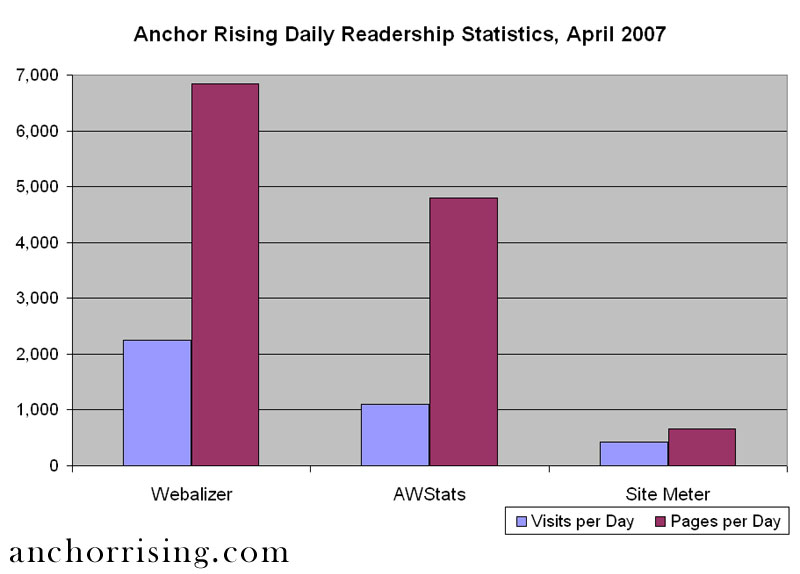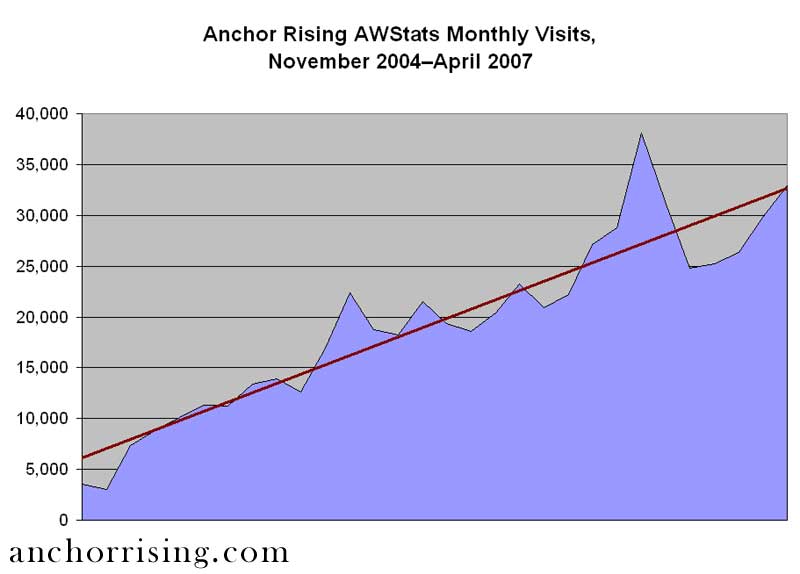A Lesson in Web Stats (Because Nobody Else Will)
We could legitimately declare that Anchor Rising has had 94,250,358 hits, or 101,009 per day, over the life of the site, but that would be deceptive. I mention this because from time to time you’ll see a site parading the fact that it’s had x number of hits, and if that’s all the information you’re given, it’s just about impossible to know what it really means. The main problem is that, in conversational usage, hits means page views, or (in advertising lingo) impressions, and some folks even take it to mean readers. With respect to the statistics that most Web page owners have concerning their sites, however, those are all different measurements:
- Hits are typically the number of files downloaded, or even requests for files. So, if you were to click over to a page with 25 photographs, an audio file, and 50 design-related images (such as the various parts of the yellow line that traces Anchor Rising), then that one page view would count (including the actual html file) as 77 hits. If you accidentally close your browser and reload the page, then depending how much information your computer has cached (or saved on your hard drive for future reference), you might trigger that many more hits again.
- Page views are more akin to what print media types track as impressions. That’s the number of downloaded files with extensions that typically indicate full pages — such as .html or .php. So, even if none of the pictures on our hypothetical Web page come through, you would have counted as two page views. If you were to come to Anchor Rising, click to read the comments, and then make a comment of your own, your activity would count as four page views — the main page, the comment page, the preview page, and the reloaded comment page with your comment.
- Visits are generally tracked according to page views with a given interval between them. Those four page views would count as one visit, but if you were to contemplate your comment for half an hour (or some other interval of time, longer or shorter) before making it, the two sessions would count as separate visits.
- Uniques or sites are individual IP addresses and, although there are qualifications that I’ll describe in a moment, might be thought of as the number of people reading the page in a given time period.
Of these four metrics, I’ve tended to keep the closest eye on visits, because as you can see, hits are next to meaningless from a real-people standpoint, and pages can be quickly racked up, but there is increased value to readers who come back several times a day. (There’s also the possibility that different people are using the same computer, or even the same home network, thus counting as the same IP address.) For comparison purposes, however, using the same metric still isn’t precise, because different software programs track visits differently.
For one thing, some track downloads of a particular picture. The colorful square on the bottom of our left-hand column is an example, and related statistics are based on the number of times that image is downloaded. Of course, if somebody is reading a text-only version of a page or has images blocked or has cached the image, he won’t count. If the tracking service is hung up and the person manages to read everything he wants before it loads, that page view won’t count, either. For this reason, some folks place the image at the tops of their html, to ensure that it gets counted; sometimes, though, delays can be considerable, so since we prefer your value as interested readers to your value as statistics, it’s the very last thing that Anchor Rising offers to your computer.
Other tracking software works directly on the server, which is obviously more accurate. Even so, some count or don’t count different extensions as pages, as opposed to files (such as .css style sheets). Some track visits every half-hour; others on the hour. Some appear to make adjustments that even I haven’t cared to figure out. When looking at average-per-day statistics, some go back to the Web site’s very first day, and others use only a certain period of time, such as a month or year. Thus, our average number of daily page views is currently 677 on the lowest of our four tracking systems, while it is 36,075 on the highest.
And then, even adjusting for all of this, the impression that one gets of a site’s popularity has to be adjusted with reference to the computer behind each request. Every time Google checks to see what words we’re using, that counts as traffic. Every time a spammer’s bots probe our site for weaknesses, that counts. Every person who clicks over from a search engine to quickly skim a two-year-old post for relevance or to see a searched-for image in context counts. Every potential advertiser. Every person who’s just trying to copy our html.
So, if you owned a Web site, which numbers would you use? When asked, I’ve always tried to offer a realistic estimate based on my general understanding of our statistics, even though I’ve realized that comparisons might therefore be unfair to us. Then again, something tweaks my conscience at the thought of taking credit for the “readership” of some automated computer program that downloaded a one-pixel JPEG image. Similarly, while I do not want people to underestimate our numbers, it would cross a line into a distasteful sliminess to deliberately lead them to exaggerated conclusions — or even to allow them to mislead themselves.
For these reasons — as well as to enable a concrete application of today’s Web stat lesson — the following is an untweaked snapshot of our daily visits and page views using three different programs. (I’ve left out the high-end outlier, from which I derived the above eye-poppers.) For a little bit of extra context, our Web host appears to think that Webalizer is more accurate than AWStats. Site Meter is the software based on that colorful image on the bottom of our left-hand column.
Although it would be reasonable to simply go with the Webalizer data (which, I’m told, is the most popular statistics measurement online), for interviews and conversation, I usually give a rough average of Webalizer and AWStats. I’d note, though, when comparing with other types of Web sites, and even more so other types of media, that blog readers tend to be especially plugged in — in a variety of senses; there’s also considerable difference even among blogs in the type of content they offer and in the way in which readers use them. That’s why, for my own purposes, I concentrate on our readership trends (which are really the only information for which I use Site Meter at all), and on their basis, I’ve no reason to complain or to be coy:
Having little sense of what y’all might have thought before, I don’t know whether any of this is surprising to you, whether in a good or bad way. From our perspective, we’re more interested in having you come by because you’re interested in what we have to say than because you think we’re the happening conservative bloggers of the region.




I’ve only been aware of Anchor Rising for a few months but wanted to let you know that it is one of three sites that I log onto daily (well, almost daily.) I never considered myself a true “conservative,” but find myself agreeing with, or at least intrigued by the thoughts and ideas expressed by the five contributors. I also enjoy the give and take with your commentators, some of whom actually make some valid points.
Thanks for keeping the blog fresh, thoughtful and lively.
Justin,
Megadittos, of course … and thanks for the nifty AR hat.
Excellent explanation of the subtle, but important differences between the various concepts you described.
PS I’m not sure what the exact expenses are to run the website, but perhaps you could put an AR mechandise link on the website, so that people can support AR by buying its branded products? People always like to give money more when they get something tangible in return.
Great summary. It’s always complicated to explain the four different categories of numbers to people. I similarly only use Visits and Visitors as a worthwhile indicator of traffic.
RIFuture.org uses Awstats and we have these numbers for this month so far:
Unique Visitors – 30,198
Number of Visits – 88,419